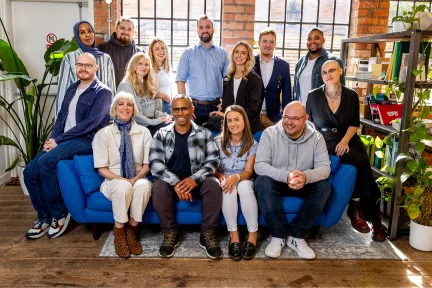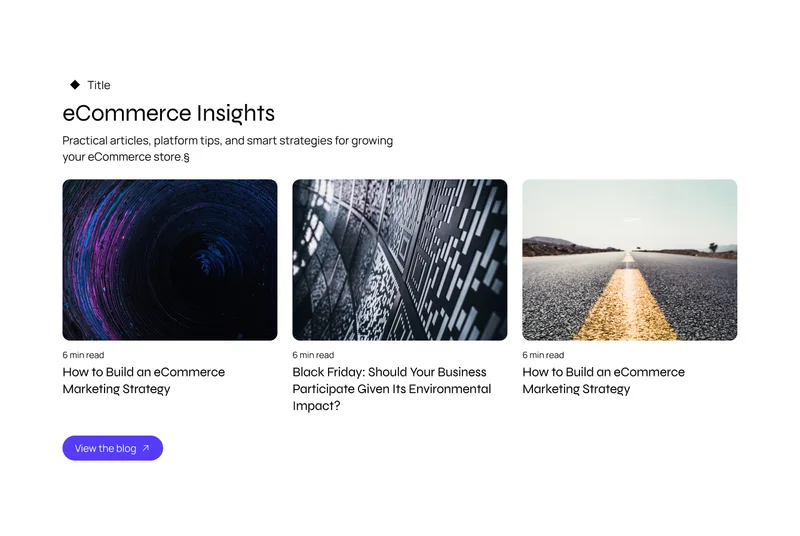November 8, 2022
The ever-evolving nature of eCommerce means merchants and suppliers are continually adopting new and updated technology, keeping up with digital trends and learning new terminology. We’ve consolidated some of the most common terms used by eCommerce professionals to provide a handy resource for you to refer back to when required.
A/B testing –
Also known as ‘split-testing’ is where two different variables on a web page are tested and compared to see which one performs better.
Affiliate marketing -
A performance-based activity where a product or service is promoted by an advertiser who earns a commission for every sale made via their ad.
Abandonment -
Describes when a user leaves a page before completing the desired action. For example, when someone adds products to their shopping cart but exit without completing their order.
Acquisition -
In simple terms, customer acquisition is the process of getting potential customers to your platform using eCommerce marketing strategies including SEO, PPC, social & email marketing etc.
Application Programming Interface ‘API’ -
An API is a software intermediary that allows interaction between two pieces of software for example you may have a review platform (reviews.io) integrated with your website (Magento). The API allows for information to be pulled between the two.
Black Friday -
Takes place on the last Friday in November, usually shortly after Thanksgiving. It’s the biggest retail day in the USA and has become increasingly popular in other countries. Brands tend to offer some of their best promotions of the year during Black Friday.
Bounce Rate -
The percentage of visitors who enter a site but leave without engaging. It’s calculated by dividing the total amount of one page visits with the total amount of overall visits to the page or site.
Business to Business ‘B2B’ -
A commercial transaction between two businesses. In eCommerce terms this could be a relationship between a manufacturer and wholesaler or wholesaler and retailer.
Bundling -
The process of grouping or ‘bundling’ products together on your web store. Bundles usually include products that are commonly purchased together, sometimes at a discounted price.
Buy to Detail Rate -
The percentage of site visitors who buy a product after viewing that specific product page. It’s calculated by dividing the number of unique products purchased by the number of times the product has been viewed.
Content Delivery Network ‘CDN’ -
A group of servers based in different geographical locations that work together to provide speedy delivery of web content.
Call to Action ‘CTA’ -
Text that aims to encourage the user to take an action, usually in the form of a button or link. For example ‘add to cart’.
Click Through Rate ‘CTR’ -
A percentage that represents users who click on a link (either a search result or email link) vs the number of times it is viewed (impressions). It’s calculated by dividing the number of clicks by the number of impressions, then multiplied by 100.
Cloud-Based -
This refers to digital data or technology that is stored and accessed via a remote network of servers rather than a local server or computer.
Content Management System ‘CMS’ -
Software that allows users to create, manage and edit digital content without development experience. For example, Magento & Adobe Commerce has the ‘Pagebuilder’ feature where you can create new pages from scratch without code.
Conversion -
When a visitor completes a specific goal on a website such as making a purchase, completing a form or making a call.
Conversion Rate -
The percentage of site visitors who complete a specific goal on a website. This is calculated by dividing the number of conversions by the number of visitors or interactions.
Conversion Rate Optimisation ‘CRO’ -
Techniques or actions to improve conversion rate. For example, this could be highlighting best-selling products in a carousel on a homepage or offering a discount if a user goes to exit a page.
Cookies -
Text files that are created when users visit a specific website. They save browsing information which can allow businesses to keep users logged in, remember their preferences for future visits, track visits via Google Analytics, and remarket to previous visitors.
Customer Relationship Management ‘CRM’ -
Software used to manage business interactions with customers and potential customers. It helps track information and promote customer loyalty and satisfaction.
Cross-sell -
Also known as ‘add-on’ products, it’s the process of encouraging customers to purchase products in addition to the ones they were already interested in. For example, if a customer is looking at phone cases, a common cross-sell would be a phone case or phone charger.
Cyber Monday -
The Monday that follows Black Friday, this day originally signified the end of Black Friday/cyber weekend, however many sales now continue beyond this.
Direct to Consumer ‘D2C’ -
A business model where the brand sells and sends their product directly to the end customer.
Dropship -
Where an online seller accepts orders but does not hold any stock. For example, John Lewis sells a number of different products, but for many of these products they don’t hold physical stock in their warehouse.
Email Flow/Programme -
An automated series of emails, triggered by an action (subscribe, order, competition entry) sent to subscribers with the aim of achieving a particular outcome. For example, a Welcome Programme is designed to introduce a brand to prospective customers with the aim of encouraging them to trust their brand and eventually purchase from them.
Enterprise Resource Planning ‘ERP’ -
Software used by businesses to centralise and manage their day-to-day business processes. It allows data to be shared easily between all areas of a business to improve efficiency and analysis.
Eprocurement -
The B2B sale of products and services through a web interface or networked system.
Faceted Navigation -
Also known as ‘Faceted Search’, it’s a technique which allows site visitors to filter and sort their search and category results based on a set of product attributes. The filter usually sits in the sidebar of the page and allows users to narrow down results, providing more relevant content.
File Transfer Protocol ‘FTP’ -
A process where files are transferred between devices or platforms over a network. It can be used with an internal network of computers or online between different servers.
Headless Commerce -
Put simply, it’s the separation of the back end and front end of an eCommerce application. Rather than communicating directly between the two, they use APIs to transfer data. This provides flexibility, allowing for changes to the front end without affecting back end processes as well as the ability to integrate best-in-class tools.
Hyvä Theme -
A theme is a component of Magento which makes up the visual look and feel for the front end of a website. Hyvä is a theme founded by Willem Wigman focussed on improved performance and reduced complexity.
Marketplace -
An eCommerce platform where users can browse & shop products and brands sold by different third parties or ‘vendors’. For example Amazon, eBay & Wayfair.
Mega Menu -
An expandable site menu which displays a large number of categories in a two-dimensional dropdown layout.
Merchandising -
The process of organising products across a site or within a category, usually to optimise conversions (aka "category merchandising"). For example, during a sale you might merchandise sale products at the top of your categories to encourage sales of these products.
Net Promoter Score ‘NPS’-
A measurement used to determine customer loyalty & satisfaction using one question: “On a scale from 0 to 10, how likely are you to recommend this product/company to a friend or colleague?”.
Pay Per Click ‘PPC’ -
A type of advertisement where the advertiser pays a platform when a user clicks on their ad and lands on their website. Both Google & Facebook offer PPC advertising.
Persona -
Semi-fictional characters that represent individuals and groups within an audience that help you create marketing strategies to target your customers.
Point of Sale System ‘POS’ -
Facilitates sales and payments. This could be a standard till in a store, or for eCommerce this can represent a system which allows store staff to place orders & take payments in person via the brand’s website. It means all transactions and data are held in one place.
Product Attributes -
A set of features that describe an item, for example Colour, Size & Material. When used within search & navigation, these can help customers find products more easily. They can also help businesses manage and organise their products more efficiently on their chosen platform.
PunchOut Catalogue -
A catalogue that resides on a supplier’s eCommerce platform, but is viewable by customers using their own e-procurement system. The buyer can browse and add items to the cart while both applications maintain their connections. We specialise in Magento Punchout and you can read our blog "What is Punchout?" here.
Progressive Web App ‘PWA’ -
An app built from web technologies including HTML, CSS and Javascript. It’s essentially a website that looks and behaves like a mobile app.
Return on Investment ‘ROI’ -
A way of determining profitability of an investment such as an advert. It’s shown as a percentage which is calculated by dividing net profit or loss by its initial cost.
Retargeting/Remarketing -
Advertising to potential customers who have already completed an action relating to a business. For example, showing a Facebook ad to people who have visited your website or using Google display ads to retarget people who have watched your YouTube video.
Segmentation -
The process of splitting data into different groups to identify targeted groups of consumers. It allows businesses to tailor their marketing, merchandising & branding in a way that suits that specific group.
Search Engine Optimisation ‘SEO’ -
The process of improving a website’s content, link popularity and technical configuration to improve its position in search engine rankings.
Social Proof -
A psychological phenomenon where people are more likely to do something if others approve or are doing it too. In marketing this relates to reviews, positive comments across social media and influencer marketing.
Touchpoint -
When a prospective or previous customer comes into contact or interacts with your brand throughout their buying journey. For example, they might see a TV advert, then a campaign on social media, then visit your website.
Up-sell -
Encouraging a customer to spend more money by purchasing additional items or the premium/more expensive version to what they’re currently considering.
User Experience ‘UX’ -
How a user is able to interact with a website or platform during their visit. It encompasses all aspects of an end-user’s interaction and their feeling towards the platform. Put simply, a negative User Experience will likely result in a lower conversion rate and higher bounce rate.
User Interface ‘UI’ -
The point at which a human interacts with a computer, for example the front end of an eCommerce website or ePOS system.How many of these eCommerce terms do you know?
Last updated: March 11, 2025






